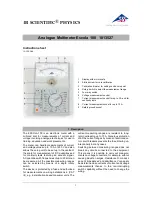
4
2.26
Do not use the meter if either the meter or the test leads are wet, either from
exposure to the weather, or after cleaning the case of the meter. Doing so
may cause injury to the user.
2.27
Do not attempt immediate use of the meter when bringing it from a cold
environment to a warm environment. Condensation of water, inside and
outside of the meter, may produce dangerous measuring conditions. Allow
the meter to warm to room temperature before using. Failure to observe
this precaution may result in damage to the meter or injury to the user.
2.28
Do not modify the meter. Changing the design may make the meter unsafe
and may result in injury to the user.
2.29
Use caution when attempting to evaluate if a dangerous voltage is present.
The meter will not read AC voltage if it is set to DC, nor will it read DC if it
is set to AC. For example, if the meter is set to 200VDC, it will not measure
a dangerous AC voltage, even if the probes are inserted into a household
AC wall outlet.
2.30
Do not touch the metallic portion of one test lead if the other test lead is
connected to a live circuit. The current from the live circuit may pass
through the meter and appear on the unconnected test lead. Failure to
observe this warning may result in user injury.
2.31
Do not attempt to use meter when no display is present on LCD. Doing so
may damage the meter and/or injure the user.
2.32
Use caution when measuring circuits containing capacitors. Capacitors can
store dangerous or lethal levels of electricity, even when the circuitry which
they are in has been disconnected from its power source. Some capacitors
could source enough energy to damage the meter and/or injure the user.
2.33
Do not use this meter to measure voltages or currents in industrial applica-
tions where High Energy circuitry is used. High Energy circuitry is usually
regarded as any circuitry capable of supplying over 4000 watts to a load
before a safety device (like a fuse) interrupts the circuit. See product
specifications for Category II statement.
2.34
Do not use this meter to measure current in circuits whose open circuit
voltage exceeds 250V AC/DC. The meter’s fuses are rated at 250V max.
Failure to observe this precaution may result in damage to the meter or
injury to the user.
Downloaded from
Arrow.com.
Downloaded from
Arrow.com.
Downloaded from
Arrow.com.
Downloaded from
Arrow.com.
Downloaded from
Arrow.com.






































